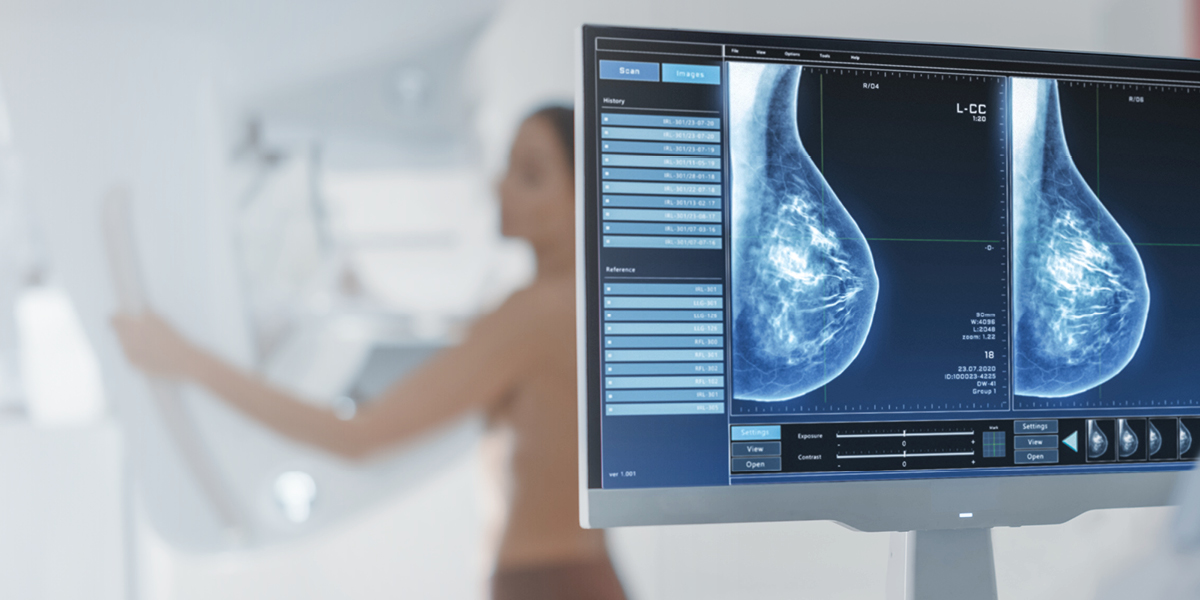In the ever-evolving landscape of mammography screening and diagnostics, the integration of artificial intelligence has become an essential tool and partner for radiologists. Imaging centers considering the adoption of AI solutions for detection, density assessment, and risk evaluation face decisions that extend beyond the technology.
This post outlines the essential factors that will help guide the decision-making process to ensure a seamless transition and maximize the benefits of incorporating AI into your facility’s breast imaging workflows.

Comprehensive, diverse, and compliant deep learning AI solution.
An AI solution needs to exceed a baseline standard of functionality to be considered. It’s important how the algorithm is trained, validated, and in compliance with world-wide regulations.
✓ Find a comprehensive solution that includes all aspects of breast cancer AI in one system.
Ask about features for early detection, density assessment, and near-term image-based breast cancer risk evaluation (in the next one or two years) and long-term lifetime risk assessment (family and medical history).
Some systems only address one or two elements, requiring you to either implement multiple solutions or only a few solutions into your screening process
✓ Regulatory compliance is essential to use any solution in production.
Ask about FDA clearance, CE marking, and Health Canada licenses for each solution.
Ensure that the chosen AI solution complies with relevant regulatory standards and requirements. Understanding and adhering to regulations such as FDA approval and CE certification is vital for patient safety and legal compliance.
✓ An AI algorithm is only as good as its training dataset.
Ask how the algorithm was trained – specifically, how diverse and comprehensive is the data set, including both 3D tomosynthesis and 2D FFDM mammography scans, what are the total number of cancers within the data set, and what is the representation of geographic areas, ethnicity, race, and age of those within the data set.
And ask about the mammography screening data that is also informing the algorithm, including:
Ipsilateral correlations: Algorithm refines scoring based on the matching or non-matching of suspicious lesions observed between the CC and MLO views.
Prior mammogram: Algorithm refines scoring based comparisons of suspicious lesions observed between the current image and prior image.
Proven significantly better for clinicians and patients.
AI solutions significantly improve the experience and performance of clinicians and produce improved patient outcomes, making it worth the cost of investment.
✓ Clinically proven accuracy is key.
Adding a second set of eyes to your radiology workflows requires extensive validation and testing with proven clinical results.
Start your evaluation by assessing the clinical validity and accuracy of the AI-powered mammography solution. Look for solutions that have undergone rigorous testing and validation, ideally with clinical studies demonstrating improved detection rates and reduced false positives. A robust clinical foundation is paramount for building trust in the technology among your medical team.

✓ Improved accuracy in detecting cancer, even before it’s visible.
Screenings with AI should demonstrate improved accuracy (both in specificity and sensitivity) and improved patient outcomes.
Ask to see case studies and clinical research using the solution that demonstrates improved accuracy. By reviewing extensive retrospective exams, a partner should be able to clearly demonstrate how their solution calls attention to areas of concern in prior scans, even when there might not have been a discernable lesion.
✓ User experience should add to the process, not detract from it.
Radiologists should have an enhanced user experience, where they are not inundated with marks on the scan that distracts more than helps.
Ask to see the case studies of scans using and not using the solution. Earlier, less trained solutions tend to inundate clinicians with so many markings they become ubiquitous and easy to ignore. When the AI solution marks a lesion or provides a risk score, it should be reliable and cause the clinician to take notice.
Seamless integration into existing workflows.
✓ Integrate seamlessly with existing systems, workflows, and deployment environments.
Look for a solution that can be customized to fit your specific workflows for intake, readings, and communication. The goal is to enhance, not disrupt, existing processes. A solution that seamlessly integrates into your daily operations and improves workflow efficiency is key to successful implementation. Consider how seamlessly the AI-powered software integrates with your existing radiology systems such as the PACS, gantry, or other systems. Smooth integration ensures minimal disruption to workflow, enabling a more efficient and cohesive radiology environment.
Ask about interoperability partners and proven integrations with your existing systems and workflows. Ensure your facility’s deployment requirements are offered, whether it’s on-premises or in the cloud.
✓ Grows with you to match your deployment and scalability needs, now and in the future.
Choose a solution that can scale with the growing demands of your breast imaging practice. Whether you operate a small clinic or a large hospital, the AI-powered mammography solution should offer scalability and flexibility to adapt to changing workloads and evolving technological landscapes.
Evaluate the user interface of the software to ensure that it is intuitive and user-friendly. Radiologists and technicians should be able to easily navigate through the system, maximizing efficiency and minimizing the learning curve associated with new technology.
✓ Align with Quality of Care Standards.
AI-powered mammography is playing a role in helping breast imaging centers align to important quality standards and accreditation programs.
• Mammography Quality Standards Act (MQSA)
• National Quality Measures for Breast Centers (NQMBC) Program
• National Accreditation Program for Breast Centers (NAPBC)
• Institute for Healthcare Improvement Quintuple Aim of Healthcare
• American College of Radiology (ACR) Accreditation Program
Ask how a potential partner and solution adheres to these quality programs, demonstrating a commitment to quality by adhering to industry best practices and guidelines, ultimately maximizing positive patient outcomes.
✓ Access, network, and patient data security is essential.
Prioritize the security and privacy of patient data. The AI-powered mammography software should adhere to the highest standards of data protection, including encryption, secure access controls, and compliance with healthcare privacy regulations.
Trusted partner to work alongside your team.
✓ Align with an innovative thought leader in breast health care.
Align with a partner at the forefront of innovation. Look for a track record of fostering an environment of collaboration, shared expertise, and a commitment to staying ahead of industry trends.
Ask a potential partner about their history in the industry, partnership with industry-leading radiology health systems, and new solutions addressing the ever-growing insights provided by a screening mammogram.

✓ A partner should help you stay in compliance with changing regulations.
By September 2024, all US radiology facilities need to be in compliance with FDA communication requirements to notify patients if they have dense breasts, since it’s a leading breast cancer risk factor. Adopting an integrated AI-powered solution today helps to support compliance alignment before the deadline.
✓ Deep variety of customers, partners, and industry-leading medical advisors.
Look for a solution supported by a diverse customer base, including hospitals, radiology groups, and clinics. A wide-ranging partner network further validates the solution’s credibility and includes your facility into a deep user community of leading radiologists.
Explore the partnerships a company prioritizes to understand their commitment to comprehensive breast health care. Partnerships should include organizations that help facilities integrate seamlessly, as well as dedicated partnerships advancing research and breast health advocacy organizations.
Your AI partner should have an active, robust Medical Advisory Board. Ask how often the leadership team meets with their medical advisors, and a summary of the features and protocols that have been put in place based on their advisement.
✓ Provides continuous improvements and upgrades.
Regular upgrades and a proactive approach to stay at the forefront of technological advancements ensure a facility won’t need to be constantly re-evaluation the solution in the future.
Select a partner committed to continuous improvement. Ask about company’s history of product upgrades and their plans for the future.
✓ Proven history of listening to customers for next generation versions of solution.
A reliable partner has a history of actively listening to customer feedback, including incorporating insights into the development of next-generation versions and addressing any concerns promptly.
Ask for testimonials of clinicians who have been customers for multiple years, and learn how their suggestions and feedback has been received and incorporated into the solution.
✓ Commitment to team onboarding, ongoing training, and support.
Evaluate the onboarding process and the availability of ongoing training and support. A partner invested in your success will ensure a smooth transition and continued proficiency. Ensure the vendor offers responsive customer support to address any issues or questions that may arise during the implementation phase and beyond.
Ask about the specific offerings provided in the partner’s customer success and onboarding program.
Ensure a successful adoption and return on your investment.
✓ Calculate ROI beyond the initial investment.
Investing in AI is not just a financial commitment; it’s an investment in improved patient care and operational efficiency. Evaluate the return on investment by considering long-term gains in accuracy, improved cancer detection, reduced false positives, improved patient outcomes, and lower reading teams with the potential for increased patient throughput. A detailed cost-benefit analysis will help you make an informed decision and demonstrate the value of AI to stakeholders.

✓ Adoption is key. Empower your team for success.
Introducing AI into your workflow requires a thoughtful change management strategy. Engage your radiology and information technology team early in the process, providing training and support to ensure a smooth transition. By fostering a culture of continuous learning, you empower your team to embrace AI as a valuable tool, enhancing their diagnostic capabilities and job satisfaction.
What are your next steps?
Selecting the right AI-powered mammography partner and solution is a pivotal decision that can positively impact patient care and the overall efficiency of your breast imaging practice. By carefully considering factors such as clinical validity, integration capabilities, regulatory compliance, scalability, user-friendliness, data security, training and support, and ROI, you can make an informed decision that aligns with the goals and values of your facility.
Embrace the future of breast imaging with confidence, knowing that you’ve chosen both a partner and a solution that empowers your team and enhances the quality of care for your patients.
Ready to get started?
If you’re just starting your evaluation journey, make sure you’ve reviewed the previous two posts in this series.
